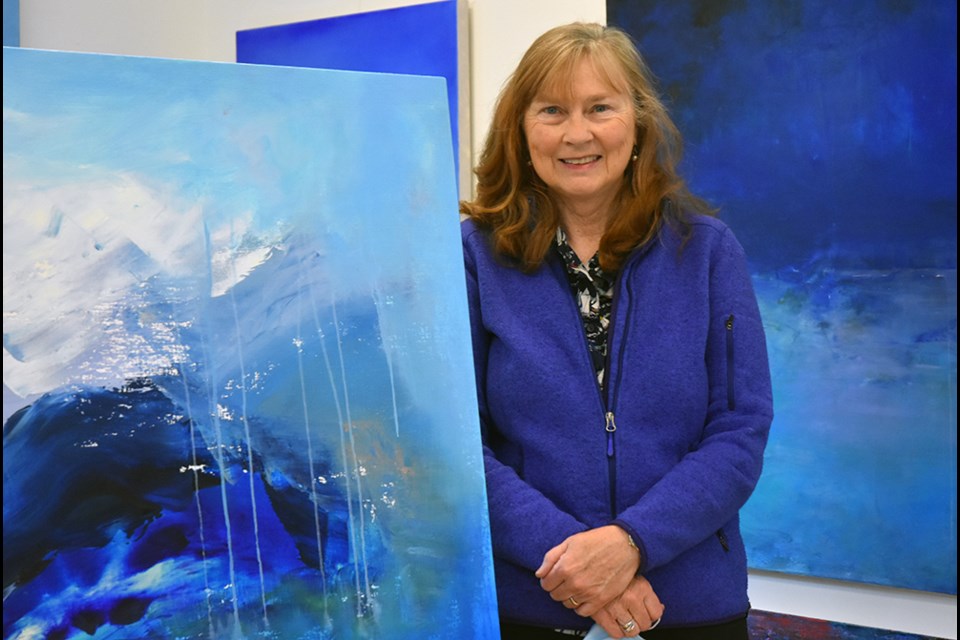Janet Read has always had a special relationship with water.
Growing up in Shanty Bay on the north shore of Kempenfelt Bay, “I learned to swim at the government dock,” she says, at the age of only three.
And while other kids swam and played in the water, for Read the connection was more visual, and transformative.
“Throw the water up in the air - you’d have diamonds!” she says.
As an artist, Read has continued to be fascinated by the interplay of water, air and light, finding metaphor in the blurring of the boundaries between the elements.
As she works at her art studio, now located on the south shore of Kempenfelt Bay in Innisfil, she is still fascinated by that interplay.
“Water is so changeable, and the atmosphere is changeable,” she says. “It’s always changing...”
One art show curator has called Read’s paintings “allusions of landscape” – abstract expressions of the littoral zone where water meets land, the meeting place between atmosphere and ocean. They can be interpreted as landscapes, but they are not a specific location or site - they are distillations of impressions that evoke wind, clouds, seascapes, fog and ice.
She is inspired by the places she visits, but “I don’t paint by sight. It’s all by memory,” she explains. “I work from my interior imagination…. I start with patches of colour, and then I take it from there.
“It’s a process, figuring out what’s happening.”
When Read has painted a recognizable scene, it’s been largely by accident.
She recently completed a large 30 x 60 canvas, before realizing it looked familiar. “It was totally unconscious,” she says. “When I finished it, I said - it’s a real place!” It was in fact Quilakitsoq in the Arctic, looking towards Uummannaq, Greenland, a location she visited while on a trip to the high Arctic in 2018.
Read has found inspiration wherever she has lived or travelled – in Port Hope, while in residency at Pouch Cove in Newfoundland, and on the Dingle Peninsula in Ireland, and especially her voyage to the Arctic.
There, the experience resulted in a change in her colour palette – shifting towards azure blues and icy aquas, with just a touch of reds and purples, hinting at the wildflowers of the arctic tundra or lights hidden in the ice.
“It’s just the most amazing landscape. It feels like the atmosphere is clearer, higher, more domed,” she says. All of her Arctic works have a sense of space and light that combine to create a transcendental experience for the viewer.
The canvases are large, giving Read the “elbow room” to get physical as she builds the planes, blocks and layers of colour.
“The physicality of a large painting really suits what I am doing,” she says. “What I’m interested in is the water and the atmosphere above the water,” and especially the meeting of air, land and sea.
“It is in our western thinking that things are discrete. The littoral area is where things are interpenetrating, where things interact,” she explains. “I’m not fond of hard distinctions. Everything is interconnected.”
Read describes her recent works as among her most abstract, suggesting that some of her earlier paintings are more obviously landscapes, more “figural.”
Light Opens over Water, a series of drawings in oil and graphite on Duralar, a translucent film, are abstract and luminous but recognizable as landscapes; her Newfoundland collection, Ocean as Vessel, explores not only the relationship between land and sea but also the impact of the loss of the cod fishery, placing the paintings in a cultural context.
There is never any overt symbolism; there is instead an interpretation of imagery and use of colour to express Read’s internal vision.
Curator Christian Bernard Singer has called her works “landscapes of consciousness,” engaging and challenging the viewer to appreciate the beauty in what can be an immersive experience, suspended between sea, sky and atmosphere.
“It’s that moment,” Read says. “As human beings, light is a metaphor for all human states… We don’t look at one thing. We look at everything in relation to everything.”
Read hopes to be able to return to the Arctic in the fall of 2022. If she does, she won’t be cataloguing the impact of climate change. Instead, she will focus on experiencing a changing world, absorbing not only the viewpoints of the scientists who accompany the voyage, but also the interpretations of the Indigenous people for whom the landscape is home.
“I react as an artist,” she says. “I’m not interested in depicting what I see. I’m interested in what I feel” – and in sharing that emotional vision, through her vibrant works.
If the trip doesn’t take place, she isn’t worried: she has enough memories and imagery stored up to keep painting.
“How does the imagination keep turning that over, and mining that lode? Somehow it does!” she says. Her residency in Newfoundland, for example, “was one of those seminal experiences,” Read says. “It was several years of being propelled by that experience.”
Read’s works have been shown at the Robert McLaughlin Gallery in Oshawa, Varley Gallery, Art Gallery of Northumberland, and Orillia Museum of Art and History, where she has been part of the Carmichael Landscape Exhibition. She has also participated in the annual Innisfil Studio Tour, and currently shows at the Rebecca Gallery in Toronto, and the Propeller Artist Centre collective on Queen Street West.
Her Arctic paintings – which include titles like Vernacular of Light; and the wind speaks; and Tundra Light – were part of a solo show, ‘High Arctic Light’ at the Heliconian Club in Toronto, an organization that supports women in the arts and literature. The solo exhibit will be returning to the Heliconian for in-person viewing in May 2022.
Her works can also be viewed online; click here.



